
DIpil Das
US
| What’s New? | Trend Data | Positive or Negative* |
| Earnings vs. Inflation: In the US, Inflation increased in December, surpassing a record-setting November. Consumer prices rose by 7.0% year over year as inflation continued to gain pace from an already considerable jump in November. Consumer price growth was led by increases in the prices of shelter, used cars and trucks, and food, according to the Bureau of Labor Statistics. Average weekly earnings growth decelerated slightly to 4.7% year over year in December from 4.8% in November. The unemployment rate declined further than anticipated in December. Unemployment fell by 0.3% month over month to 3.9%—well below the 5.0% level that is typically considered to be full employment by economists. Nevertheless, job growth was slow in December as the US added just 199,000 workers in nonfarm payrolls. |
Average Weekly Earnings vs. Consumer Prices: YoY % Change 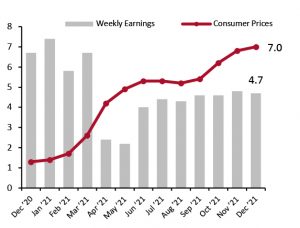 |
|
| Food and Fuel Prices: Food and gas price inflation rates are significant metrics because higher costs in these categories can impact discretionary spending. December saw US food inflation continue to climb, slightly picking up pace from November. This month, food price inflation was driven by a 0.9% month-over-month increase in the index for fresh fruits and vegetables. Gasoline price inflation is beginning to ease but remains high year over year. High rises in gas prices are the result of a rapid recovery in demand and a tightening of global crude supply by the Organization of the Petroleum Exporting Countries (OPEC). On November 22, President Biden announced the administration will utilize the Strategic Petroleum Reserve (SPR). The US intends to release 50 million barrels of oil from the SPR to combat the rapid rise in fuel inflation in 2021. Since peaking in November, the price of gas per gallon has since fallen, as it appears inflation pressures are starting to ease due to the usage of the SPR. |
Consumer Prices for Food at Home and Gasoline: YoY % Change 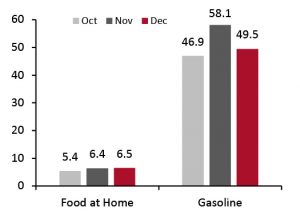 |
|
| Retail Sales: Total US retail sales, excluding gasoline and automobiles, grew by a strong 13.3% year over year and by 22.3% when compared to pre-pandemic 2019 values. Total holiday sales growth was 12.9% Many sectors saw strong sales growth in December 2021 compared to December 2019: Sales increased by 39.6% at miscellaneous store retailers, by 39.5% at sporting goods, hobby, musical instrument, and bookstores, by 18.5% at clothing and clothing accessory stores, and by 14.8% at general merchandise stores. US department store sales closed out a strong recovery year, seeing sales increase by 1.2% compared to 2019 pre-pandemic values. |
Total Retail Sales ex. Automobiles and Gasoline: YoY % Change [caption id="attachment_140120" align="aligncenter" width="300"]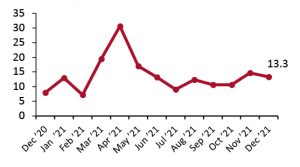 Data are not seasonally adjusted [/caption] Data are not seasonally adjusted [/caption] |
UK
| What’s New? | Trend Data | Positive or Negative* |
| Earnings vs. Inflation: In the UK, inflation continued to climb in December. Consumer prices grew 4.8% year over year, marking the third consecutive month of inflation acceleration, increasing from November’s 4.6%. Average earnings growth decelerated for the seventh consecutive month in November to 3.5% (latest data), from 4.3% in October. As in the US, consumer price increases are outpacing average weekly earnings growth in the UK, which will negatively impact consumers' spending ability. In December 2021, the number of payroll employees increased slightly to 29.5 million employees, totaling an increase of 184,000 employees compared to November. Compared to pre-pandemic February 2020, the number of payroll employees is currently 409,000 higher. |
Average Weekly Earnings vs. Consumer Prices: YoY % Change [caption id="attachment_140121" align="aligncenter" width="300"]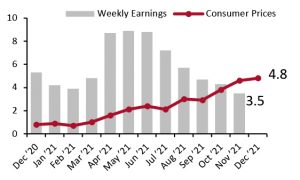 Latest earnings data are for November Latest earnings data are for November Source: ONS [/caption] |
|
| Food and Fuel Prices: Higher costs for food and automotive fuel can impact discretionary spending. In November, UK food price inflation continued to slowly accelerate to 4.2% year-over-year growth, up from November’s 2.5%. Automotive fuel price inflation appears to be easing while remaining high, growing 26.8% year over year this month. |
Consumer Prices for Food at Home and Automotive Fuel: YoY % Change 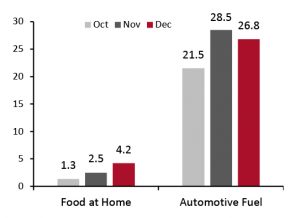 |
|
| Retail Sales: Total UK retail sales growth was solid in December, growing 5.3%—however, this was driven by shop-price inflation of 4.8% and was against weak December 2020 comparatives, when sales declined by 0.2%. Volume growth was very weak, at 0.4%. Retail sales growth was expedited in December by a notable acceleration at small retailers, which saw sales grow 7.8% year over year. Sales at department stores and mixed-goods retailers grew 2.1% year over year but declined by 8.5% on a two-year basis. Health and beauty retailers’ sales continued to see strong growth in December, increasing by 13.2% year over year and 12.6% on a two-year basis. Online sales continued to see declines (of 6.9%) against strong 2020 comparatives. However, on a two-year basis, online sales were up 35.7%. |
Total Retail Sales ex. Automobiles and Automotive Fuel: YoY % Change [caption id="attachment_140123" align="aligncenter" width="300"]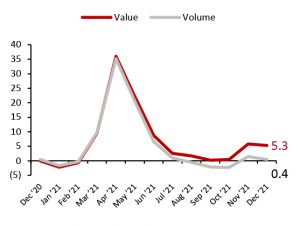 Data are not seasonally adjusted[/caption] Data are not seasonally adjusted[/caption] |
|
China
| What’s New? | Trend Data | Positive or Negative* |
| Income vs. Inflation: In China, the consumer price index grew just 1.5% year over year in December, a slowdown from 2.5% in November. Data on per capita disposable income are released quarterly. In the fourth quarter of 2021, per capita disposable income grew 5.4% year over year, down from the 10.4 % in the second quarter of 2021, but still remaining healthy. Growth in disposable income is outpacing increases in consumer prices, a net positive for consumers' ability to spend. However, the economy’s recovery is being challenged by a struggling real-estate market as the government implements its newest five-year plan, alongside natural disasters from earlier in the year affecting the supply chain, and sporadic coronavirus outbreaks. |
Per Capita Disposable Income vs. Consumer Prices: YoY % Change [caption id="attachment_140124" align="aligncenter" width="300"] Disposable income data are quarterly[/caption] Disposable income data are quarterly[/caption] |
|
| Food and Fuel Prices: Higher costs for food and automotive fuel can impact discretionary spending. In December, food prices in China remained mostly unchanged, seeing just a marginal decline of 0.1%. Beijing’s fuel price inflation––paralleling the US and UK––eased in December, while remaining high. Fuel prices increased by 24.1% year over year, down from November’s 31.6%. |
Consumer Prices for Food at Home and Automotive Fuel: YoY % Change 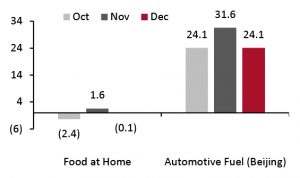 |
|
| Retail Sales: Year-over-year retail sales growth slowed in December to just 2.3%, as China’s zero-tolerance policy toward Covid-19 confronted the infectious Omicron variant, prompting regional lockdowns. Apparel and footwear retailers’ sales continued to decrease on a year-over-year basis in December, by 2.3%—representing the fifth consecutive month of easing declines. On a two-year basis, sales were marginally negative at 0.2%. This sector is likely impacted by China’s strict Covid-19 restrictions aiming to contain sporadic local outbreaks. Beauty retailers’ sales lost momentum in December, growing 2.5% compared to a year ago, down from November’s 8.2% year-over-year growth. Daily necessities saw the largest growth of any sector, increasing by 18.8% year over year and 24.6% on a two-year basis. Food retailers saw continued steady growth of 11.3% year over year and 13.5% compared to the same period in 2019. Online retail sales accounted for a substantial 29.4% of all retail sales in December. Online sales penetration was likely boosted in December by the strict restrictions on movement imposed amid the spread of the Omicron variant in China. |
Total Retail Sales incl. Automobiles and Gasoline: YoY % Change [caption id="attachment_140126" align="aligncenter" width="300"]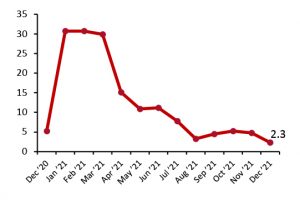 Data for January and February 2021 are aggregated[/caption] Data for January and February 2021 are aggregated[/caption] |